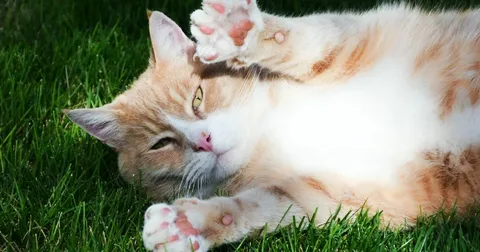Cats are known for their quirky behaviors, and one of the most puzzling yet endearing actions is kneading.
If you’ve ever watched your cat press its paws into a soft surface, rhythmically pushing in and out, you’ve seen the mysterious act of kneading.
It’s often accompanied by purring and sometimes even drooling, leaving many cat owners wondering: Why do cats knead?
Kneading is an instinctive behavior that dates back to kittenhood, but it remains with most cats into adulthood.
While it may seem like a simple act, the reasons behind it are complex and multifaceted, tied to both the cat’s physical development and emotional well-being.
The Origins of Kneading: Kittenhood Instincts
To understand why cats knead, it helps to look at the behavior from a kitten’s perspective. When a kitten is nursing from its mother, it instinctively kneads her belly with its tiny paws.
This action, known as “milk treading,” helps stimulate the mother’s milk flow, making it easier for the kitten to nurse.
The kneading motion is deeply ingrained in the cat’s neurological system as part of the nurturing process, and even as adult cats, they may retain this behavior.
While they no longer need to knead for milk, the motion often becomes associated with comfort, relaxation, and feelings of safety.
In fact, adult cats can exhibit the same kneading behavior on soft surfaces, such as blankets, pillows, or even their owner’s lap, because it reminds them of the comfort they felt as kittens.
Kneading as a Comforting Behavior
In addition to its origins in kittenhood, kneading has psychological and emotional benefits for cats. As adult cats continue to knead, they often seek comfort and reassurance.
Similar to how humans might fidget with a stress ball or wrap themselves in a cozy blanket, kneading offers a sense of calm and security for cats.
This is why cats are often seen kneading their favorite soft objects or the lap of their trusted human companions when they are feeling content or relaxed.
The act of kneading releases endorphins in a cat’s brain, the same “feel-good” hormones that help reduce stress and promote feelings of well-being.
Just like how people might find comfort in the familiar scent of their favorite blanket or the warmth of a loved one, cats associate kneading with comfort and safety.
Marking Territory with Pheromones
Another reason cats knead could be related to marking territory. Cats have scent glands in their paws that release pheromones when they knead.
These pheromones carry a unique scent signature that marks their presence in a particular space.
When a cat kneads an area, it’s not just a sign of affection; it’s also a way of claiming that space as their own.
This territorial behavior is common among both indoor and outdoor cats, though it’s especially noticeable when cats knead on objects that have strong associations with them, like their bed or a favorite chair.
Interestingly, this territorial marking is not aggressive—it’s more about establishing a space where the cat feels safe and comfortable.
It’s a way for cats to communicate to other animals that this area is “theirs.”
Kneading as a Sign of Affection
Many cat owners notice that kneading often occurs during moments of deep bonding with their pet.
If your cat kneads on your lap or your chest, it’s often a sign of affection. It’s their way of saying, “I trust you” or “I feel safe with you.”
In a sense, cats treat their human companions as they would their mothers—purring and kneading as a way of showing care and creating a bond.
This affectionate behavior can also be linked to a cat’s social needs. While cats are often thought of as solitary creatures, they can form strong attachments to their human families.
Kneading is one of the ways that cats maintain these emotional connections, ensuring they feel secure in their relationships.
When Kneading Becomes Excessive
Though kneading is a normal and healthy behavior, some cats may knead excessively, leading to scratches or damage to furniture.
If your cat’s kneading becomes problematic, it’s important to first assess whether they are experiencing stress or anxiety.
Changes in their environment—such as a new pet, a move, or a change in routine—can trigger more frequent kneading as a coping mechanism.
In such cases, providing your cat with plenty of interactive toys, scratching posts, and comforting spaces can help alleviate their need to knead excessively.
If the behavior is causing harm or seems compulsive, consulting with a veterinarian or feline behaviorist may be a good idea to rule out any underlying health or emotional concerns.
Conclusion: The Meaning Behind Kneading
Kneading is a deeply ingrained behavior that connects cats to their early experiences with their mother and serves as a comfort-seeking ritual in adulthood.
Whether it’s about feeling safe, marking territory, or showing affection, kneading remains one of the most endearing and distinctive cat behaviors.
So, the next time your cat curls up in your lap and begins to knead, you can rest assured that it’s a sign of trust, love, and contentment.
It’s a reminder of the deep bond that exists between humans and their feline companions—one paw at a time.



